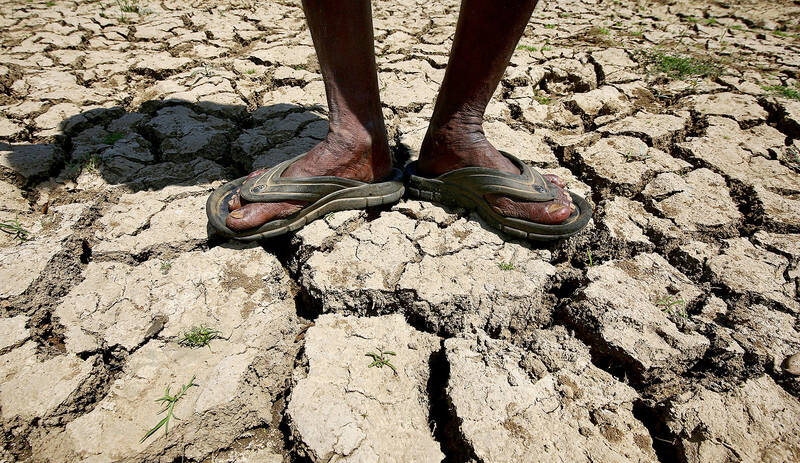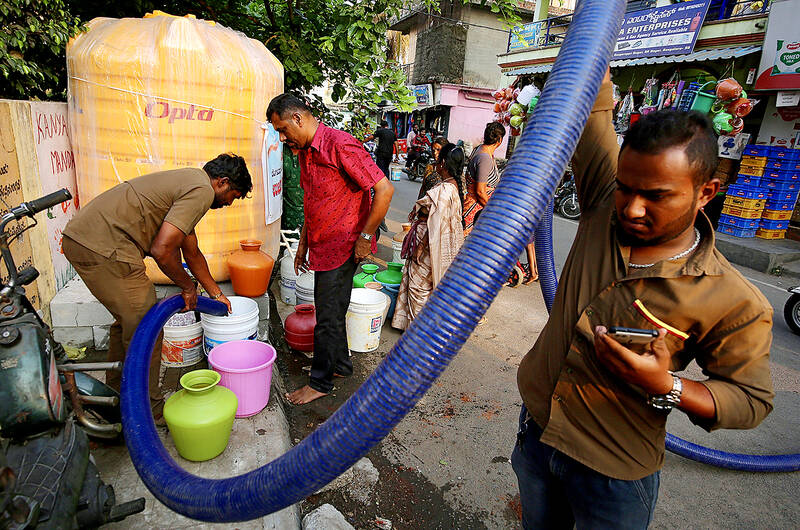Bhavani Mani Muthuvel and her family of nine have around five 20-liter buckets worth of water for the week for cooking, cleaning and household chores.
“From taking showers to using toilets and washing clothes, we are taking turns to do everything,” she said. It’s the only water they can afford.
A resident of Ambedkar Nagar, a low-income settlement in the shadows of the lavish headquarters of multiple global software companies in Bengaluru’s Whitefield neighborhood, Muthuvel is normally reliant on piped water, sourced from groundwater. But it’s drying up. She said it’s the worst water crisis she has experienced in her 40 years in the neighborhood.

Photo: EPA-EFE
CLIMATE BREAKDOWN
Bengaluru in southern India is witnessing an unusually hot February and March, and in the last few years, it has received little rainfall in part due to human-caused climate change. Water levels are running desperately low, particularly in poorer areas, resulting in sky-high costs for water and a quickly dwindling supply.
City and state government authorities are trying to get the situation under control with emergency measures such as nationalizing water tankers and putting a cap on water costs. But water experts and many residents fear the worst is still to come next month and May when the summer sun is at its strongest.

Photo: EPA-EFE
The crisis was a long time coming, said Shashank Palur, a Bengaluru-based hydrologist with the think tank Water, Environment, Land and Livelihood Labs.
“Bengaluru is one of the fastest growing cities in the world and the infrastructure for fresh water supply is not able to keep up with a growing population,” he said.
Groundwater, relied on by over a third of the city’s 13 million residents, is fast running out. City authorities say 6,900 of the 13,900 borewells drilled in the city have run dry despite some being drilled to depths of 460 meters. Those reliant on groundwater, like Muthuvel, now have to depend on water tankers that pump from nearby villages.
Palur said El Nino, a natural phenomenon that affects weather patterns worldwide, along with the city receiving less rainfall in recent years mean “recharge of groundwater levels did not happen as expected.” A new piped water supply from the Cauvery River about 100 kilometers from the city has also not been completed, adding to the crisis, he said.
Another concern is that paved surfaces cover nearly 90 percent of the city, preventing rainwater from seeping down and being stored in the ground, said TV Ramachandra, research scientist at the Centre for Ecological Sciences at Bengaluru-based Indian Institute of Science. The city lost nearly 70 percent of its green cover in the last 50 years, he said.
Ramachandra compared the city’s water shortage to the “day zero” water crisis in Cape Town, South Africa, 2018, when that city came dangerously close to turning off most taps because of a drought.
DRY TIMES
The Indian government estimated in 2018 that over 40 percent of Bengaluru residents won’t have access to drinking water by the end of the decade. Only those that receive piped water from rivers outside Bengaluru are still getting regular supply.
“Right now, everyone is drilling borewells in buffer zones of lakes. That is not the solution,” Ramachandra said.
He said the city should instead focus on replenishing the over 200 lakes spread across the city, stop new construction on lake areas, encourage rainwater harvesting and increase green cover across the city.
“Only if we do this will we solve the city’s water problem,” he said.
Palur added that identifying other sources and using them smartly, for example by reusing treated wastewater in the city “so that the demand for fresh water reduces,” could also help.
Until then, some residents are taking serious measures. S. Prasad, who lives with his wife and two children in a housing society made up of 230 apartments, said they have begun water rationing.
“Since last week we’ve closed the water supply to houses for eight hours every day, starting at 10am. Residents have to either store water in containers or do everything they need to in the allotted time. We are also planning on installing water meters soon,” he said.
Prasad said their housing society, like many others in Bengaluru, is willing to pay high costs for water, but even then it’s hard to find suppliers.
“This water shortage is not only impacting our work but also our daily life,” Prasad said. “If it becomes even more dire, we’ll have no choice but to leave Bengaluru temporarily.”

A jumbo operation is moving 20 elephants across the breadth of India to the mammoth private zoo set up by the son of Asia’s richest man, adjoining a sprawling oil refinery. The elephants have been “freed from the exploitative logging industry,” according to the Vantara Animal Rescue Centre, run by Anant Ambani, son of the billionaire head of Reliance Industries Mukesh Ambani, a close ally of Prime Minister Narendra Modi. The sheer scale of the self-declared “world’s biggest wild animal rescue center” has raised eyebrows — including more than 50 bears, 160 tigers, 200 lions, 250 leopards and 900 crocodiles, according to

They were four years old, 15 or only seven months when they were sent to Auschwitz-Birkenau, Bergen-Belsen, Buchenwald and Ravensbruck. Some were born there. Somehow they survived, began their lives again and had children, grandchildren and even great grandchildren themselves. Now in the evening of their lives, some 40 survivors of the Nazi camps tell their story as the world marks the 80th anniversary of the liberation of Auschwitz-Birkenau, the most notorious of the death camps. In 15 countries, from Israel to Poland, Russia to Argentina, Canada to South Africa, they spoke of victory over absolute evil. Some spoke publicly for the first